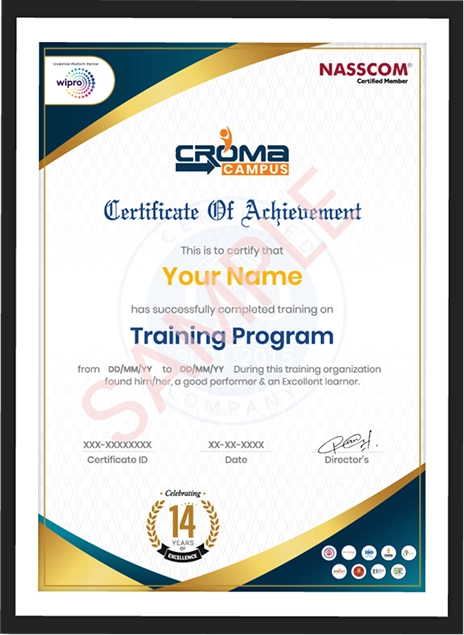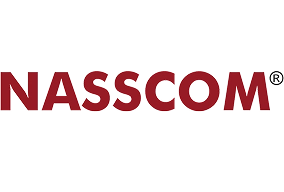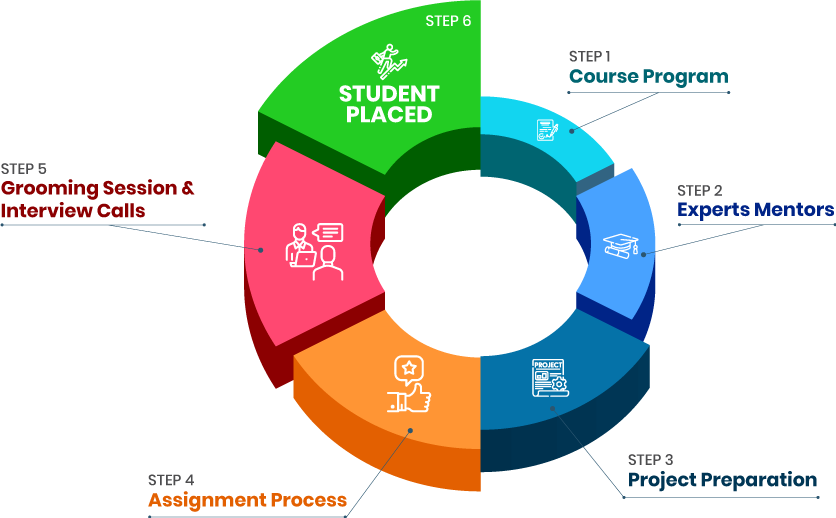- 2 Live Project
- Self-Paced/ Classroom
- Certification Pass Guaranteed
Course Offered By
Our course is designed to teach students how to use the Microsoft Dynamics Software suite to create or customise reports, dashboards, templates, and more.
After completing our Microsoft Dynamics Business Central training course in Delhi, you will be able to build, customise, and deploy an MS Dynamics software suite that is tailored to your company's needs and budget.
After completing Microsoft Dynamics certification training, you will be able to use a variety of functions in the MS Dynamics software package efficiently.
Our knowledgeable instructors will help you fully comprehend MS Dynamics automation, customisation, and engagement components.
By enrolling in the best Microsoft Dynamics training facility in Delhi NCR, you will improve your skills and become the chosen candidate for any company.
The tool assists firms in updating their processes in the most efficient way feasible.
Companies looking to manage their activities and operations and make them more hassle-free are in high demand for Microsoft Dynamics Professionals.
In today tech-dominated world, specialists with expertise of MS dynamics command the best compensation when compared to other software products.
A Microsoft Dynamics professional's annual compensation is typically around $97,000.
Microsoft Dynamics 365 is currently used by more than 60% of industries.
You must know how to create reports, dashboards, templates, and other items using the Microsoft Dynamics Software package.
You must be able to perform skills more efficiently in the job.
You must understand how to use the MS Dynamics software suite's numerous capabilities.
To prove your worth in an organisation, you must be familiar with MS Dynamics automation and customization, as well as other related approaches and components.
By selecting the top Microsoft Dynamics training facility in Delhi NCR, you will be able to easily manage all of these jobs and duties.
we train you to get hired.
we train you to get hired.
By registering here, I agree to Croma Campus Terms & Conditions and Privacy Policy
Functional Roles & New Company Setup
Sales
Purchase
Warehouse and Transfer Order
Manufacturing
GST
Configuration Package
Chart of Account
Bank
Master
General Entries
No. Series
Permissions
Inventory
Fixed Assets
Workflows
What is an D365 Business central ERP
Concept on an ERP
Why Dynamics 365 business central is more successful
Modules of Functional in Business central.
Role of Functional Person in Business Central
Characteristics of Functional
Difference between Nav and Business Central.
Creation of New Company.
Creation of Chart of Account.
Accounting Period and accounting sub period.
Complete setup after creating the blank company
How to enter the opening of customer, vendor, Bank and Employee
Basic concepts of sales Lead/Sales Quotation/Sales order
Sales & Receivable Setup
Creation of Sales Order and Effect of Sales Order after Posting
Sales Shipment/ Sales Invoice/Sales Shipment and Invoice
Sales Shipment Return/Sales Return/Sales Credit Memo
Lab: Show Example on above mention related to sales.
Basic concepts of Purchase / Purchase Order.
Purchase & Payable Setup
Creation of Purchase Order and Effect of Purchase Order after Posting
Purchase Receipt/ Purchase Invoice/Purchase Receipt and Invoice
Purchase Return/Sales Credit Memo
Lab: Show Example on above mention related to Purchase.
Warehouse employee setup
Location setup for simple warehouse Lesson 3: warehouse receipt
Warehouse ship
Entry after posting warehouse receipt
Entry after posting warehouse shipment
Advance warehouse
Advanced warehouse setup on location
Creation of zone and bin
Transfer bin item from one bin to another.
Creation of entry on the zone then pick to bin
How to use the bin contents
Warehouse entry
Basic concepts of Inventory/Inventory Setup
What is Transfer Order How the Movement Occurs
Creation of Transfer Order and Effect of Transfer Order after Posting
Transfer shipment/ Transfer Receive
Work on Inventory Adjustment/Positive and Negative adjustment
Lab: Show Example on above mention related to Purchase.
Define CRM; differentiate configuration, customization, extendingand development; design appropriate customizations; identify documents in the Microsoft Dynamics CRM implementation guide
Understand business requirements, understand the benefits of solutions, create solutions, export managed and unmanaged solutions, import solutions, describe default solution, specify a publisher, work with multiple solutions, describe solution components
Describe component dependencies; describe customization concepts for entities, fields, forms, views and charts; publish customizations
Describe business units, describe Microsoft Dynamics CRM security features, identify privileges and access levels for security roles, describe security role interaction with business units
Create and maintain users, create owner teams, describe owner teams and sharing, manage security roles for users and teams, differentiate owner teams and access teams, create access team templates, add access team sub-grids to forms
Identify entities for which field-level security is available, create field security profiles, define field permissions, add field permissions, assign field security profiles to users and teams
Enable entity-level auditing, enable field-level auditing
Describe entity customization concepts; create custom entities; configure display names, plural names and schema names; configure entity ownership; create custom activity entities; set primary fields
Configure entity properties including display areas, communication and collaboration options, fixed properties, data services options, Microsoft Outlook options, mobile options; modify custom entities; delete custom entities; identify dependencies
Describe field customization concepts, create fields, describe ways new fields can be created, delete custom fields
Identify field data types; identify field display formats; configure the requirement level field property; configure searchable, audit and field security field properties; identify properties that can be changed for existing fields
Configure local and global option sets, configure status and status reason fields, describe dependencies, create calculated fields, describe the purpose of rollup fields, create rollup fields
Identify different relationship types; describe one-to-many, many-to-many and manual many-to-many relationships; describe special many-to-many relationships such as marketing list members, queue items and follows; identify supported and unsupported relationships; identify cascading behaviors such as Assign, Share, Unshared, Re-Parent, Delete
Create entity relationships, map fields, manage connections and connection roles, work with relationship hierarchy visualization
Define CRM; differentiate configuration, customization, extendingand development; design appropriate customizations; identify documents in the Microsoft Dynamics CRM implementation guide
Understand business requirements, understand the benefits of solutions, create solutions, export managed and unmanaged solutions, import solutions, describe default solution, specify a publisher, work with multiple solutions, describe solution components
Describe component dependencies; describe customization concepts for entities, fields, forms, views and charts; publish customizations
Describe business units, describe Microsoft Dynamics CRM security features, identify privileges and access levels for security roles, describe security role interaction with business units
Create and maintain users, create owner teams, describe owner teams and sharing, manage security roles for users and teams, differentiate owner teams and access teams, create access team templates, add access team sub-grids to forms
Identify entities for which field-level security is available, create field security profiles, define field permissions, add field permissions, assign field security profiles to users and teams
Enable entity-level auditing, enable field-level auditing
Describe entity customization concepts; create custom entities; configure display names, plural names and schema names; configure entity ownership; create custom activity entities; set primary fields
Configure entity properties including display areas, communication and collaboration options, fixed properties, data services options, Microsoft Outlook options, mobile options; modify custom entities; delete custom entities; identify dependencies
Describe field customization concepts, create fields, describe ways new fields can be created, delete custom fields
Identify field data types; identify field display formats; configure the requirement level field property; configure searchable, audit and field security field properties; identify properties that can be changed for existing fields
Configure local and global option sets, configure status and status reason fields, describe dependencies, create calculated fields, describe the purpose of rollup fields, create rollup fields
Identify different relationship types; describe one-to-many, many-to-many and manual many-to-many relationships; describe special many-to-many relationships such as marketing list members, queue items and follows; identify supported and unsupported relationships; identify cascading behaviors such as Assign, Share, Unshared, Re-Parent, Delete
Create entity relationships, map fields, manage connections and connection roles, work with relationship hierarchy visualization
we train you to get hired.
Phone (For Voice Call):
+91-971 152 6942WhatsApp (For Call & Chat):
+91-971 152 6942Stories
success
inspiration
career upgrade
career upgrade
career upgrade
career upgrade
You will get certificate after
completion of program
You will get certificate after
completion of program
You will get certificate after
completion of program
in Collaboration with

Empowering Learning Through Real Experiences and Innovation
we train you to get hired.
Phone (For Voice Call):
+91-971 152 6942WhatsApp (For Call & Chat):
+91-971 152 6942Get a peek through the entire curriculum designed that ensures Placement Guidance
Course Design By
Course Offered By
Ready to streamline Your Process? Submit Your batch request today!
Microsoft Dynamics 365 Business Central Training in Delhi is a program designed to provide individuals with the skills and knowledge needed to work with the Business Central platform.
Microsoft Dynamics 365 Business Central Training in Delhi is beneficial for individuals who want to learn how to work with the Business Central platform.
Microsoft Dynamics 365 Business Central Training covers topics such as financial management, supply chain management, inventory management, and reporting.
The duration of Microsoft Dynamics 365 Business Central Training varies depending on the program and level of training.
Highest Salary Offered
Average Salary Hike
Placed in MNC’s
Year’s in Training

fast-tracked into managerial careers.
Get inspired by their progress in the
Career Growth Report.
FOR QUERIES, FEEDBACK OR ASSISTANCE
Best of support with us
For Voice Call
+91-971 152 6942For Whatsapp Call & Chat
+91-9711526942





















